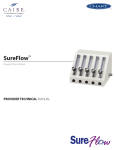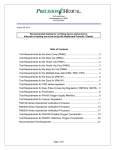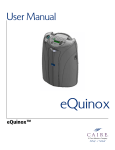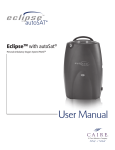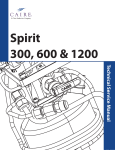Download Liberator/Low Loss
Transcript
Liberator L I B E R A T O R® Low Loss P AT I E N T O P E R AT I N G INSTRUCTIONS ™ LOW LOSS Liberator/Low Loss Warning Information • In the event of an accidental tip-over, immediately but cautiously return unit into an upright position. If any liquid oxygen is escaping, leave the area immediately and call your health care provider. Read this page carefully before using your unit. • The unit contains liquid oxygen which is extremely cold; almost 300 degrees below zero Fahrenheit. Exposure to such a low temperature can cause severe frostbite. • Do not touch the frosted parts of any unit. • Liquid and gaseous oxygen, though nonflammable, cause other materials to burn faster than normal. This hazard, along with the low temperature of liquid oxygen, warrants certain safety precautions. • Applicable EMC information can be found in the Liberator Service Manual at www.cairemedical.com. • Do not store or operate the portable coupled to the Liberator/Low Loss. Explanation of Other Symbols • Do not use or store your unit in an area where combustible materials such as oils, greases, aerosol sprays, lotions or solvents are present. Name and address of manufacturer Authorized representative in the European Community • Do not smoke while operating unit. Caution, consult accompaning documents • Do not use or store your unit within five feet of electrical appliances, especially stoves, heaters, toasters, and hair dryers. Non-flammable gas • Keep your unit in a well-ventilated area. Oxidizing substances 1 Type B Applied Part (degree of protection against electric shock) Patient’s Records Patient’s Name Prescribed Oxygen Flow Setting Doctor’s Telephone Number Distributor’s Name Person to Contact Distributor’s Emergency Telephone Number Special Instructions 2 Liberator/Low Loss Table Of Contents Introduction Controls Important: Read this manual thoroughly before operating the Liberator/Low Loss. 5-6 Low Loss Operating Instructions 7 Liberator Operating Instructions 8-11 Additional Information Rx only. 4 Warning: This device is not intended for life sustaining use. Caution: Use the Liberator/Low Loss only as directed by your doctor. 12 Warning: If you feel the equipment is not operating properly, call your health care provider. Do not attempt to repair or adjust the units yourself. Specifications: • Mode of Operation: Continuous • Type of Protection Against Electric Shock: Internally Powered Equipment • Degree of Protection Against Electric Shock: Type B Applied Part • Classification according to the degree of protection against ingress of water: IPX0 - Ordinary Equipment • Equipment is not suitable for use in the presence of flammable mixtures 3 Liberator/Low Loss Introduction The liquid oxygen system includes the Liberator or Low Loss and a Portable unit, which provides you with supplementary oxygen as prescribed by your physician. This POI contains the instructions for using the Liberator and the Low Loss. Refer to the POI supplied with the Portable for its operation. The Liberator is intended for stationary use. You may take oxygen directly from the Liberator. The Low Loss has been designed to store liquid oxygen for purposes of filling a portable unit. The Low Loss is not designed to provide gaseous oxygen for breathing purposes. The Liberator/Low Loss is offered as a top fill model or a dual top fill and side fill unit. They are filled by your health care provider. The Portable provides an ambulatory source of oxygen for an extended period of time. It is filled from the Liberator/Low Loss. Dual Fill Liberator shown Also available in 10, 20, 37, 41, 45, and 60 liter models. 4 Liberator/Low Loss Controls 7 1. Gen 4 Meter Liquid Level Switch 2. Flow Control Knob 4 2 5 3. DISS Connection 3 4. Portable Release Button (Top Fill push-on style only) 5. Portable Fill Connections (see next page for QDV identification) 6. Pressure Gauge (Low Loss and 50 psi units only) 6 7. Vent Valve 1 5 Liberator/Low Loss Quick Disconnect Valve (QDV) Identification Portable Connector: Stationary Connector: QDV Style: CAIRE Side Fill SF Locking LINCARE (UC) CRYO2 LIFE-OX TF Locking 6 PENOX TAEMA TF Push-on PB Liberator/Low Loss Operating Instructions 4. Turn the Portable flow control knob to the off (0) position. 1. To verify the level of liquid oxygen in the unit, see page 9. 5. Follow the filling instructions provided for the Portable. 2. Check the pressure gauge on the Low Loss to verify that the indicator displays in the normal range (pie shaped area). Caution: Do not attempt to fill the Portable if the pressure gauge indicates other than normal levels. 3. Clean the fill connections on both the Low Loss and Portable with a clean, dry, lint free cloth. Warning: The connection must be dry, because moisture can cause the equipment to freeze together and may cause leakage in the fill connectors. 7 Liberator/Low Loss Operating Instructions 1. Use the following chart as a guideline to determine the length of time the Liberator will operate: Model Off .25 .50 .75 1.0 1.5 FCV Setting 2.0 2.5 3.0 4.0 5.0 6.0 8.0 10.0 12.0 15.0 L-20 Nominal 34-17 34-17 24-16 16-11 12-8 8-5 6-4 4-22 4-2 3-2 2-11 2-1 1-12 1-5 1-0 0-19 L-30 Nominal 50-2 50-2 35-15 23-18 17-19 11-21 8-21 7-3 5-22 4-10 3-13 2-23 2-5 1-18 1-11 1-4 L-37 Nominal 61-10 61-10 43-16 29-3 21-20 14-13 10-22 8-17 7-6 5-11 4-8 3-15 2-17 2-4 1-19 1-11 L-41 Nominal 68-14 68-14 47-22 32-7 24-3 15-15 12-2 9-4 8-1 6-1 4-19 4-6 2-22 2-8 1-23 1-13 L-45 Nominal 74-19 74-19 53-4 35-11 26-14 17-17 13-7 10-15 8-20 6-15 5-7 4-10 3-7 2-15 2-5 1-18 L-60 Nominal 90-2 90-2 68-8 45-13 34-4 22-18 17-1 13-16 11-9 8-12 6-19 5-16 4-6 3-10 2-20 2-6 Note: Times are in days and hours (format 00-00). Note: The “Nominal” times are for ideal conditions, i.e. maximum fill, exact flow rates, good loss rate, Liberator not being moved, etc. These times are the maximum expected. Note: Your individual results will vary. 8 Liberator/Low Loss 2. To verify the level of liquid oxygen in the unit with the liquid level gauge: • Depress the push button on top of the unit for two seconds minimum. Read the LED to indicate contents level. Caution: The Liberator is empty if only the first red LED is lit. • If the Low Battery Indicator lights up when the button is depressed, inform your health care provider the next time your Liberator is filled. Note: The Liberator will continue to supply oxygen even if the Low Battery Indicator lights up, as long as there is liquid oxygen in the unit. GEN 4 Meter 9 Liberator/Low Loss Caution: To ensure proper flowrate, verify fittings are tight and leak free. 3. Attach a humidifier bottle to the DISS connection provided by health care provider: • Fill the humidifier bottle with distilled water to the proper level as indicated in the humidifier instructions. • Attach your breathing cannula to the oxygen tube connector on the humidifier. 4. Turn the flow control knob clockwise until the prescribed flow rate (numeral) is visible in the knob “window” and a positive detent is felt. Caution: The knob should not be set higher than the maximum prescribed flow rate. Out-of specification oxygen flow will result if the flow control knob is set between flow rates. An indication of oxygen flow is the presence of bubbles in the humidifier bottle. *Humidifier Bottle and Cannula are not included 10 Liberator To defrost the unit: 5. Adjust your breathing cannula to the proper position to breathe comfortably. • Fill a Portable so that you can continue to receive oxygen while the Liberator defrosts. 6. You should be receiving oxygen now. Check to make sure that there are bubbles in the humidifier bottle. • Set the Liberator flow control knob to 0 and allow the unit to warm to room temperature, as indicated by the melting of all ice from the unit. 7. Under certain environmental conditions and with continuous use, the Liberator may develop an excessive amount of ice on the warming and breathing coils within the shroud. You should defrost the unit between liquid oxygen fills to prevent this ice build-up. • Check the condensation collection bottle frequently during defrosting and empty as required. Caution: Always turn the flow control knob to off (0 position) when not in use. • If the Portable runs low before the Liberator is fully defrosted, you may refill it as needed. 11 Liberator/Low Loss Cleaning Standard Our products will comply with the Restriction of Hazardous Substances (RoHS) directive. They will not contain more than trace amounts of lead or other hazardous material content. Warning: Clean only after unit is empty and vented. • Clean by applying household glass cleaner to a lint-free cloth and wipe external surfaces – do not get glass cleaner on any internal components or valves. Accessories An optional roller base is available for all models. The five casters allow the unit to be easily moved while giving great stability. • Allow unit to dry thoroughly before using. Note: Note to health care provider – for reprocessing procedures, see applicable service manual. WEEE and RoHS This symbol is to remind the equipment owners to return it to a recycling facility at the end of its life, per Waste Electrical and Electronic Equipment (WEEE) Directive. 12 2200 Airport Industrial Drive Ste 500 Ball Ground, GA 30107 U.S.A. www.cairemedical.com M. D. D. Representative: Medical Product Services Borngasse 20 35619 Braunfels, Germany Ref 13137946 Rev E

























